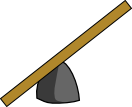Lesson 1
 The Lever
The Lever
Even if Harry does not look tired and sweaty he has been performing work.
Work is force moved through a distance. The work we have set out to do is to lift (move)3500 N(force) 1 meter (Distance). In other words we can look at these three formulas which all describe moving our rock:
Work = Force X Distance
or
Work = Force of rock (FR) X Distance the rock moves (DR)
or
3,500N or 3,500 J (Joules) = 3,500N X 1m
A Joule is the amount of work done when the force of 1 Newton moves a distance of 1 meter in the direction of the force.
Data Analysis - 2: Comparing amount of work done between trials
Harry has not actually lifted the stone 1 meter but by using the lever, that work has been done. A force has been applied to the lever arm through a distance. Use the data from table 2 to calculate the work done by Harry on each of your successful tests to complete Table 3 in your lab packet.
- What do you notice about the amount of work done in each successful trial?
- Compare the effort distance (DE) and effort force (FE) in all trials. What happens to the amount of (FE) as the (DE) increases?
- Use the term "inverse" or "direct" to explain the relationship between effort force and effort distance as you adjusted your lever. (Use complete sentences)
- What are the advantages of using a lever to lift this stone? Hints: [Could you lift the stone without the lever or any other piece of equipment? In what direction did Harry apply the force?]
In science and mathematics we describe the relationship between two variables (like effort and resistance) as either "direct" or "inverse."
Direct
In a direct relationship, if one variable increases in value, the other variable also increases. (Make more money, pay more taxes)
Inverse
In an inverse relationship, if one variable increases the other variable decreases. (Spend more money, savings goes down.)
Data Analysis - 3: Calculating Mechanical Advantage (MA)
We can give these advantages a mathematical value. It is called Mechanical Advantage (MA).
The lever we have been using works when we apply the effort force (FE) through a longer distance than the stone (FR) moves. The rock(FR) has a force of its weight (3500N) and the distance the rock moves (DR) is only 1 meter.
Harry had to move a longer distance than the stone BUT he didn't have to apply as much force. Use the same data again to complete Table 4 in your packet. When you have completed Table 4, Calculate the MA both ways for each successful test.
- Can you draw any conclusions about the MA calculated using the forces and the MA calculated using the distances for each trial?
- Comparing different trials:
- As the effort distance increases, what happens to the MA?
- As the effort distance increases, what happens to the effort force (FE)?

Talk Now - 1e
With your lab partner, create a statement explaining the mechanical advantage of using a lever to lift a heavy mass.
Complete the rest of your lab packet and then let's move on to Lesson 2 - The Ramp and Pulley.



